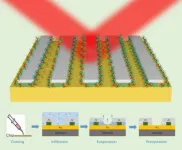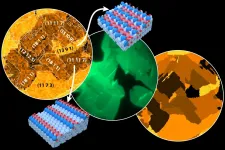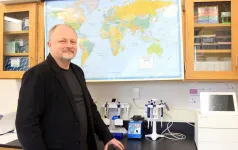High-sensitivity nanophotonic sensors with passive trapping of analyte molecules in hot-spots
2021-01-13
(Press-News.org) Optical sensors can quantitatively analyze chemical and biological samples by measuring and processing the optical signals produced by the samples. Optical sensors based on infrared absorption spectroscopy can achieve high sensitivity and selectivity in real time, and therefore play a crucial role in a variety of application areas such as environmental sensing, medical diagnostics, industrial process control and homeland security.
In a new paper published in Light: Science & Applications, a team of scientists, led by Dr. Peter Q. Liu from the Department of Electrical Engineering, the State University of New York at Buffalo, have demonstrated a new type of high-performance optical sensor which can utilize the surface tension of liquid to concentrate and trap analyte molecules at the most sensitive locations of the device structure, and hence significantly enhance the sensitivity performance. Based on a metal-insulator-metal sandwich structure which also features nanometer scale trenches, the sensor can passively retain and concentrate an analyte solution in these tiny trenches as the solution gradually evaporates on the sensor surface, and eventually trap the precipitated analyte molecules inside these trenches. As the light intensity is also highly enhanced in these trenches by design, the interaction between light and the trapped analyte molecules is drastically enhanced, leading to a readily detectable optical signal (i.e. changes in the light absorption spectrum) even at picogram level of analyte mass.
In general, different molecular species absorb infrared light at different frequencies, and therefore one can identify and quantify the detected molecules by analyzing the observed absorption lines in the spectrum. Although such molecular absorption is intrinsically weak, optical sensors can drastically enhance the molecular absorption by employing suitable nanostructures on the device surface to confine light into very small volumes (so called hot-spots), which leads to very large light intensity. In doing so, each molecule in the hot-spots can absorb much more light in a given time interval than a molecule outside the hot-spots, which makes it possible to measure very low quantity of chemical or biological substances with high reliability, if enough molecules are located in the hot-spots. This general approach is also called surface enhanced infrared absorption (SEIRA).
However, a key issue for most SEIRA optical sensors is that the hot-spots only occupy a tiny portion of the entire device surface area. On the other hand, the analyte molecules are usually randomly distributed on the device surface, and hence only a small fraction of all analyte molecules are located in the hot-spots and contribute to the enhanced light absorption. "The SEIRA signal would be much larger if most of the analyte molecules can be delivered into the hot-spots of an optical sensor. This is the key motivation of our optical sensor design." Dr. Liu said.
"There are techniques, such as optical tweezers and dielectrophoresis, which can manipulate small particles or even molecules and deliver them to target locations such as the hot-spots. However, these techniques requires significant amount of energy input and are also complicated to utilize." Dr. Liu added, "What we set out to explore is a device structure that can trap analyte molecules precipitated out of a solution into the hot-spots in a passive (requiring no energy input) and effective way, and we realized that we can make use of the surface tension of liquid to achieve this goal."
In additional to the demonstration of high-sensitivity biomolecule sensing, the team also conducted another set of experiments, which showed that the same type of device structure also achieved effective trapping of liposome particles (~100nm characteristic dimension) in the tiny trenches. This means such optical sensors can be optimized for detecting and analyzing nano-objects such as viruses or exosomes, which have similar sizes as the liposomes used in the experiments.
The scientists believe that the demonstrated SEIRA optical sensor design strategy can be applied to other types of optical sensors as well. Besides sensing applications, such device structures can also be used for manipulating nanoscale objects including exosomes, viruses and quantum dots.
INFORMATION:
[Attachments] See images for this press release:

ELSE PRESS RELEASES FROM THIS DATE:
2021-01-13
Metal surfaces play a role as catalysts for many important applications - from fuel cells to the purification of car exhaust gases. However, their behaviour is decisively affected by oxygen atoms incorporated into the surface.
This phenomenon has been known for a long time, but until now it has not been possible to precisely investigate the role of oxygen in complex surfaces point by point in order to understand the chemical background at the atomic level. This has now been achieved at TU Wien in cooperation with a team from the Elettra Synchrotron in Trieste. It became possible ...
2021-01-13
A remarkable prediction of Einstein's theory of general relativity--the theory that connects space, time, and gravity--is that rotating black holes have enormous amounts of energy available to be tapped.
For the last 50 years, scientists have tried to come up with methods to unleash this power. Nobel physicist Roger Penrose theorized that a particle disintegration could draw energy from a black hole; Stephen Hawking proposed that black holes could release energy through quantum mechanical emission; while Roger Blandford and Roman Znajek suggested electromagnetic ...
2021-01-13
Irvine, Calif., Jan. 11, 2021 - Often admired for their flawless appearance to the naked eye, crystals can have defects at the nanometer scale, and these imperfections may affect the thermal and heat transport properties of crystalline materials used in a variety of high-technology devices.
Employing newly developed electron microscopy techniques, researchers at the University of California, Irvine and other institutions have, for the first time, measured the spectra of phonons - quantum mechanical vibrations in a lattice - at individual crystalline faults, and they discovered the propagation of phonons near the flaws. The team's findings are the subject of a study published recently in Nature.
"Point defects, dislocations, stacking ...
2021-01-13
Irvine, Calif., Jan. 5, 2021 -- Scientists at the University of California, Irvine have developed a new deep-learning framework that predicts gene regulation at the single-cell level.
Deep learning, a family of machine-learning methods based on artificial neural networks, has revolutionized applications such as image interpretation, natural language processing and autonomous driving. In a study published recently in Science Advances, UCI researchers describe how the technique can also be successfully used to observe gene regulation at the cellular level. Until now, that process had ...
2021-01-13
A pioneering study by University of Bristol researchers finds that the evolution of teeth in the giant prehistoric shark Megalodon and its relatives was a by-product of becoming huge, rather than an adaptation to new feeding habits.
The iconic extinct Megalodon was the largest shark to ever roam the seas. Its name translates to 'big tooth', making reference to its massive teeth, which represent the most abundant fossil remains of the species. They are broad and triangular, nothing like the curved, blade-like teeth of the closest relatives of Megalodon.
The ...
2021-01-13
DURHAM, N.C. - Glioblastoma brain tumors are especially perplexing. Inevitably lethal, the tumors occasionally respond to new immunotherapies after they've grown back, enabling up to 20% of patients to live well beyond predicted survival times.
What causes this effect has long been the pursuit of researchers hoping to harness immunotherapies to extend more lives.
New insights from a team led by Duke's Preston Robert Tisch Brain Tumor Center provide potential answers. The team found that recurring glioblastoma tumors with very few mutations are far more vulnerable ...
2021-01-13
Even with the COVID-19-related small dip in global carbon emissions due to limited travel and other activities, the ocean temperatures continued a trend of breaking records in 2020. A new study, authored by 20 scientists from 13 institutes around the world, reported the highest ocean temperatures since 1955 from surface level to a depth of 2,000 meters.
The report was published on January 13 in Advances in Atmospheric Sciences and concluded with a plea to the policymakers and others to consider the lasting damage warmer oceans can cause as they attempt to mitigate the ...
2021-01-13
Today, the largest study of genetic diversity in Ukraine was published in the open science journal GigaScience. The project was an international effort, bringing together researchers in Ukraine, the US and China and is the first fruits of this collaboration to set up a new Central Europe Center for Genomic Research in Ukraine. Led by researchers at Uzhhorod National University and Oakland University in the US, the work provides genetic understanding of the historic and pre-historic migration settlements in one of the key intersections of human trade and migration between the Eurasian peoples as well as the identification of genetic variants of medical interest in the Ukrainian population that differ ...
2021-01-13
College campuses are at risk of becoming COVID-19 superspreaders for their entire county, according to a new vast study which shows the striking danger of the first two weeks of school in particular.
Looking at 30 campuses across the nation with the highest amount of reported cases, experts saw that over half of the institutions had spikes - at their peak - which were well above 1,000 coronavirus cases per 100,000 people per week within the first two weeks of class.
In some colleges, one in five students had been infected with the virus by the end of the fall term. Four institutions had over 5,000 ...
2021-01-13
A detailed description of how ovarian cancer cells adapt to survive and proliferate in the peritoneal cavity has been published in Frontiers in Oncology. Researchers show that structures inside the cells change as the disease progresses from benign to malignant, helping the cells to grow in an otherwise hostile environment of low nutrients and oxygen. Understanding how these cellular adaptations are regulated could herald new targeted treatment options against the fifth-leading cause of cancer-related deaths in women.
"Our study compared the structures inside cells representing different stages of ovarian cancer, including after aggregation, which enhances their survival," says Eva Schmelz, a Professor and Scientific Director at Virginia Tech University, USA, who led this research. "We found ...
LAST 30 PRESS RELEASES:
[Press-News.org] High-sensitivity nanophotonic sensors with passive trapping of analyte molecules in hot-spots





